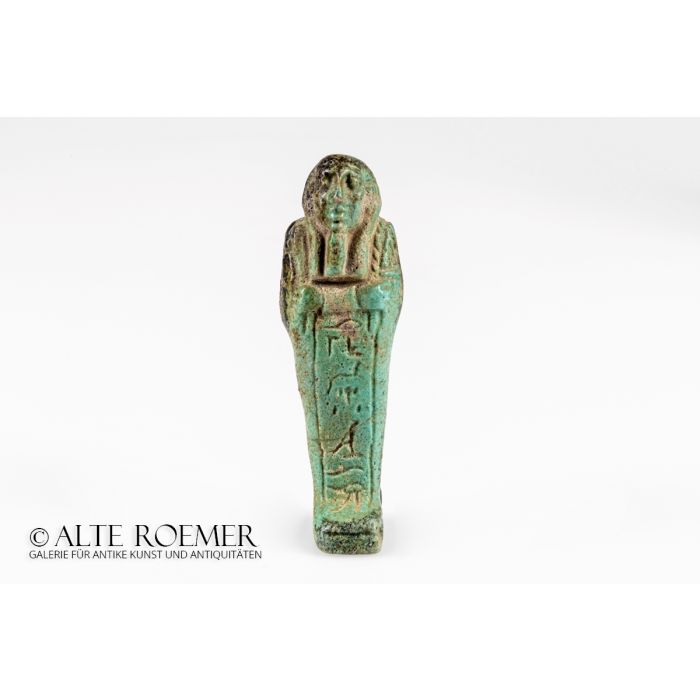Egyptian ushabti of Hor-wdja from Thebes
Price: on request
Sold
Object number
AR3019
| Object: |
Egyptian ushabti of Hor-wdja from Thebes
|
| Material: |
Light green faience
|
| Period: |
Late Period of ancient Egypt, 30th dynasty. C. 379 BC to 341 BC. |
| Description: |
Egyptian funerary statuette with a mummy shaped body and back pillar standing on a small base plate. Modelled details, wearing a tripartite wig with visible ears, attached beard. Arms crossed in front of the chest, holding an agricultural implement in each hand and a seed basket on its back. A vertical column of framed hieroglyphs engraved on the front reading: The Osiris overseer Hor-wdja The title overseer is known already in the 21st/22nd dynasty but is only widely used in the late 30th dynsty. Also the name Hor-wdja is especially popular in the Late Period of ancient Egypt. An interesting correction by the ancient craftsmen can be noticed on the column of hieroglyphs. A sign has appearently been added later to the top right corner. |
| Background: |
In Ancient Egypt, a tradition of equipping the graves of the deceased with small funerary figurines gradually became established. The figurines were made of clay, stone, wood or metal, some were covered with faience. They were named with the ancient Egyptian word for "answerer". Transcriptions for this are ushabti, shabti or shawabti. Most commonly used and apparently popular were terracotta ushabtis covered with a fine greenish or blue faience. They were usually 10cm to 20cm tall. Those who could afford it had the ushabtis elaborately engraved or simply painted. The fine engravings of many pieces survived until today. Paint suffered more from the ravages of time, but fortunately some painted figures too have been preserved. The majority of the ushabtis found shows strong erosion and can only be recognized as such by their outlines. Or they were already that basic in their appearence when made in order to cut costs. Ushabtis have been resting with the deceased since the Middle Kingdom of Ancient Egypt around the beginning of the 2nd millennium BC. The earliest known figurines date from the 11th Dynasty. It seems they represented the dead initially, but their function changed until the New Kingdom. At that time the ushabti were to serve as workers in the afterlife, standing in for the deceased, so that he or she was freed from hard physical labour (6th chapter of the Book of the Dead). With this change in purpose it made sense to add more ushabtis to the grave increasing the labour force. This resulted in up to 365 ushabtis per tomb, e.g. for Tut-Anch-Amun - one "answerer" for each day of the solar year. Either the figures were placed directly in the grave or else richly painted or otherwise decorated vessels were used for storage, the best known type being the so-called wooden ushabti boxes. |
| Dimensions: |
7.3cm height.
|
| Condition: |
Restored from two parts with visible joint at the knees. Otherwise perfectly preserved with well readable hieroglyphs.
|
| Provenance: |
Acquired by us in 2020 from G. Vandervort, USA. Previously in the collection of British archaeologist Ivor Noel Hume, who lived in the USA since the 1950ies. Mr. Hume acquired this ushabti during an Egypt trip in 1974 from the licensed dealer M. Hassani Abd-El-Galeel in Luxor (lincense no. 127). The receipt of the dealer mentions Thebes in Upper Egypt as the find spot for this figurine (a copy of the receipt comes with this item).
|
| Publication: |
A publication of this ushabti is planned by Prof. D. Kurth in his upcoming book "Hausgrabungen, Band 3 (Aegyptiaca in deutschem Privatbesitz)".
|
| References: |
Cf. H. A. Schlögl, Corpus der ägyptischen Totenfiguren der öffentlichen Sammlungen Krakaus, p. 161, no. 20. Cf. G. Janes, Shabtis: A Private View - Ancient Egyptian Funerary Statuettes in European Private Collections, p. 151, no. 79. Similar H. A. Schlögl, A. Brodbeck, Ägyptische Totenfiguren aus öffentlichen und privaten Sammlungen der Schweiz (1990), p. 319, no. 235. |
| Literature: |
A good introduction and overview on Egyptian ushabtis in just one volume is given by Glenn Janes in Shabtis: A Private View - Ancient Egyptian Funerary Statuettes in European Private Collections.
|
| Authenticity: |
We unconditionally guarantee the authenticity of every artefact, all items are subject to our lifetime return policy on authenticity.
|


